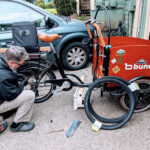When you’re looking at a typical commuter bike advertised as a 21 Speed Bike, it’s natural to assume you’re getting 21 distinct gears to tackle various terrains. However, the reality of bicycle gearing is a bit more nuanced. The straightforward answer isn’t always 21, and here’s why.
The number 21 comes from multiplying the number of front chainrings by the number of rear cogs. A 21-speed bike usually features 3 chainrings at the pedals and 7 cogs on the rear wheel. Mathematically, 3 x 7 = 21. But this simple calculation overstates the number of unique and practically usable gears.
The reason for this discrepancy lies in gear overlap and efficiency. Not every combination of front chainring and rear cog results in a significantly different gear ratio. Some combinations produce ratios that are very close to each other, essentially giving you duplicate gears. Furthermore, certain gear combinations are inefficient and can put unnecessary stress on your bike’s components, particularly the derailleur. A common example is using the largest front chainring with the largest rear cog (big-front:big-back), which is generally advised against.
Consider a popular hybrid bike like the Trek FX series as an example. These bikes often come with a front chainring setup of 48-38-28 teeth and a rear cassette of 14-16-18-20-22-24-34 teeth. If you calculate all possible gear ratios from these combinations, you’ll find there are technically 20 unique ratios. However, if you exclude the inefficient big-front:big-back combination, you’re down to 19 usable unique gear ratios.
If you consider gear ratios that are nearly identical as the same for practical purposes, the number of distinct, usable gears reduces even further. Rounding gear ratios to one decimal place reveals that many combinations are very close. In such a scenario, a 21 speed bike might offer around 15 practically different gears.
For everyday riding, especially commuting, many cyclists find that even fewer gears are truly necessary and comfortably accessible. By consciously avoiding extreme gear combinations and focusing on smooth transitions, you might effectively use around 12 gears on a 21 speed bike. This involves using the smaller front chainring with the larger rear cogs for climbing, the middle chainring with the mid-range rear cogs for most situations, and the largest front chainring with the smaller rear cogs for speed on flat or downhill sections.
Experimenting with your bike’s gears is the best way to understand its usable range. Pay attention to how each gear combination feels and sounds. By practicing and feeling the difference when you shift between front chainrings and rear cogs, you’ll intuitively discover the sweet spot of truly usable gears on your 21 speed bike, optimizing your ride for efficiency and enjoyment.


